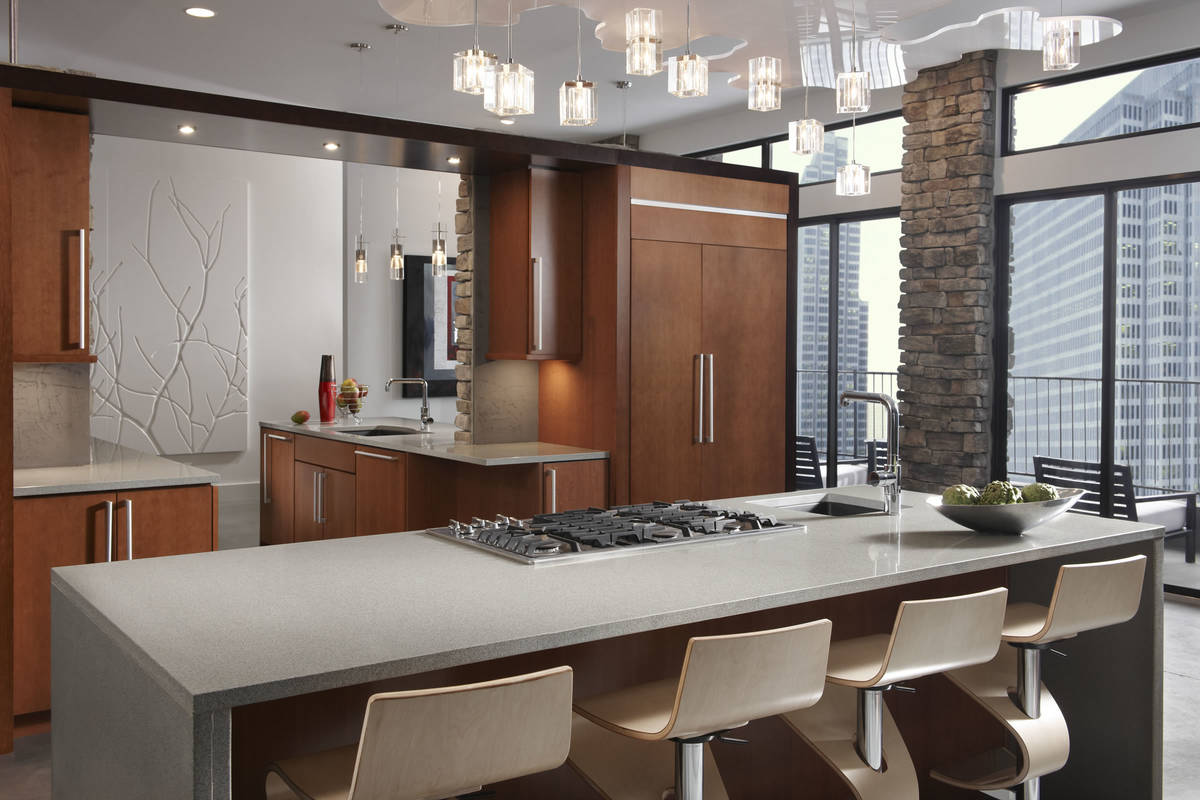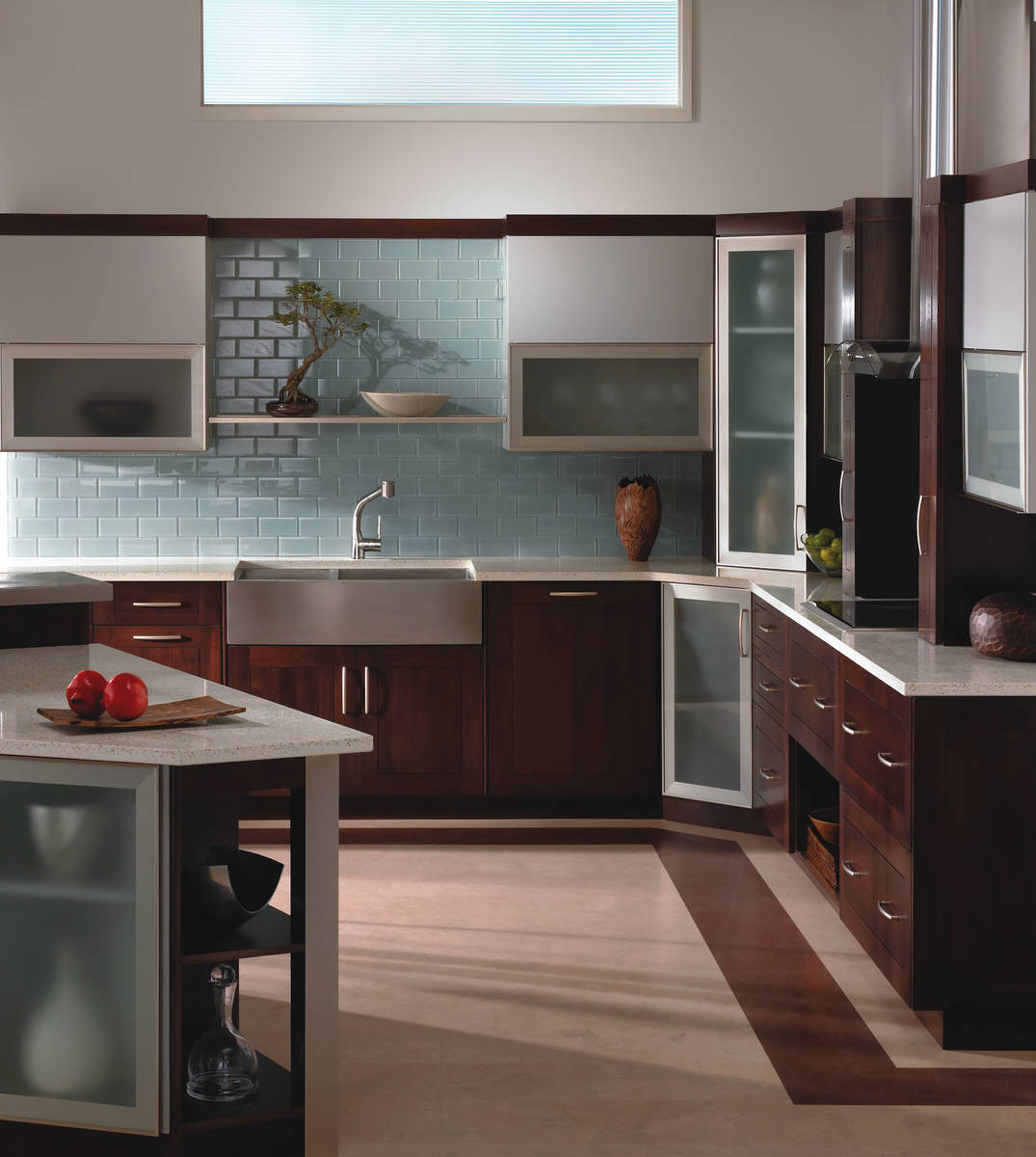Options abound for eco-friendly countertops
Sustainability is always a hot topic in interior design and home construction. In fact, it’s hard to find any type of building product category out there that doesn’t have “green” offerings in it.
That’s true for kitchen countertops as well, and when it comes to environmentally friendly options, you’ll also find a lot of creative ways manufacturers get their eco-labels. Here’s a look at some of today’s most popular sustainable countertops.
Recycled glass
Recycled glass has been a popular option for environmentally friendly counters for nearly two decades. Available in the U.S. since 2003, IceStone is among the most well-known.
The counters consist of 75 percent recycled materials from commercial glass and bottle manufacturers who sell the company their excess or defective containers. The glass is crushed to where the edges aren’t sharp and then mixed with cement. IceStone USA sells to homeowners as well as architects, fabricators and designers.
“Those who look at our products are wanting something eco-friendly with originality and beauty. Then there are others who just want something different and beautiful with the added benefit of being eco-friendly,” said Ashon McCollin, a spokesperson for Ice Stone USA.
Originally made with concrete, which is porous, the counters were recommended to be sealed annually. But the updated product released in October 2019, branded as New IceStone, is nonporous and doesn’t require sealing. It is stained and is UV- and heat-resistant. It’s now even being used on exteriors of homes, McCollin added.
The product is still evolving, too. It is 3 centimeters thick, but thinner offerings are in the works. Its polished finish comes in 17 different colors and is great for traditional or modern environments.
Paper
Yes, there are actual paper countertops out there, and they’re remarkably durable, too. PaperStone is a popular one that’s made from 100 percent post-consumer recycled paper that is melded together under heat and pressure, and it uses the company’s own proprietary petroleum-free phenolic resin, which adds to the durability of the counters.
“There’s nothing stronger out there, other than stainless steel, and that’s because of the resin,” said Ryan Bloom, director of green products for Cerami Inc., a PaperStone distributor for Nevada.
However, PaperStone can scratch, and the manufacturer recommends Osmo, a hard wax oil finish, on it. The amount of recycled paper used in the product varies from 50 percent to 100 percent, depending on color.
It comes in black, gray, brown and muted colors with a matte appearance. Price-wise, it’s on par with quartz and lends itself to classic, traditional as well as modern design.
Richlite is another paper countertop. This product is made of 100 percent recycled Forest Stewardship Council-certified paper that’s saturated in a unique phenolic resin. Richlite actually originated in the 1940s to be used for footlockers on naval ships, said Dave Mahony, a spokesperson for Royal Plywood, a Nevada Richlite distributor. Naval cooks began using it as a cutting board and popularity grew largely due to its durability.
It’s a nonporous surface that has a brown resin color as its base. It comes in seven color varieties. Some people will seal the counters with mineral oil or Osmo to protect it, but this product is largely for those who like a counter with character.
Coming in a range of thicknesses from a half-inch to 3 inches, Richlite can work well in modern kitchens, but meshes nicely with a rustic farmhouse look as well.
“It’s not for someone who wants a hard and shiny surface that never changes. This is for someone who wants to enjoy watching the aging process,” Mahony added.
Plastic
If you’re concerned about the overuse of plastic in our society, you’ll be pleased to learn of Durat. The product originated in Finland in the early 2000s when engineers and designers used industrial plastic from the growing cellphone industry. At first, designers were simply looking for a unique design, but then sustainability came into play when they recognized the availability of these unique plastics.
“Being eco-sensitive Scandinavians, they chose to solve both problems at once,” said Jessica McNaughton, president of CaraGreen, a distributor of Durat and other eco-friendly countertops.
Today, Durat also is made in Atlanta and uses recycled medical industry plastic from the U.S. that’s mixed with a polyester resin and ATH (aluminum trihydrate). Durat is seamless and manufacturers can work directly with architects and designers to shape the product to exact specs, minimizing job site scrap, even building sinks into the counter’s design as well.
“Seams and grout lines are areas where germs and bacteria collect and that’s another reason people like that it’s seamless,” McNaughton said.
Durat also is durable and can withstand heat up to 250 degrees Fahrenheit. It comes in more than 700 colors and the thin sheets are great in modern, minimalist design.
“You can have that sleek modern counter, but you can also put it in a kid’s bathroom for something a little more playful,” she also noted.
Mineral formula
From the minds who brought quartz to market more than two decades ago comes Lapitec, which is made from 100 percent Earth minerals with anti-fungal and antibacterial properties. The primary minerals in the formula are feldspars and kaolins. The product is very durable and resists stains, mold, scratches, heat; it’s non-porous and great for outdoor kitchens, too.
It’s also made with very little, if any, silica, and is 100 percent recyclable, color stable and has hydrophilic properties, meaning water doesn’t bead on the surface, which makes cleaning easy and requires less soap.
“People are really embracing this as the new technological innovation in the kitchen. For the residential market, it’s the countertop to have,” McNaughton said.
It does come with some color limitations. You’ll find it mostly in grays, black or a very bright white; but the ½-inch, ¾-inch and 1¼-inch cuts are a great addition to any modern kitchen.
The case for quartz
Quartz, among the most popular countertop options available today, is viewed as an eco-friendly option by some because it’s man-made and doesn’t require quarrying of stone.
Austrie Messer, an interior decorator with Lisa Escobar Design in Las Vegas, likes how quartz “still deliver(s) the same benefits of natural stone … is durable and does not absorb liquids, making it easy to clean and maintain.” It also doesn’t require extra time-consuming labor for refinishing and re-coating like many natural stones, she added.
“We get many clients who love white quartz with large veins — Carrera marble look-alikes that are actually quartz,” she said.
About pricing
According to experts, materials pricing for eco-friendly counters can range between 15 percent and 30 percent more than quartz. But materials are often only about a third of the total price.
While other costs may be incurred in shipping or labor, in some cases, the labor won’t be higher at all. In the case of PaperStone, for example, pricing often comes in a little under a quartz installation.
So total pricing may only be slightly higher than popular quartz or granite counters, making eco-friendly options even more attractive today than ever.
































